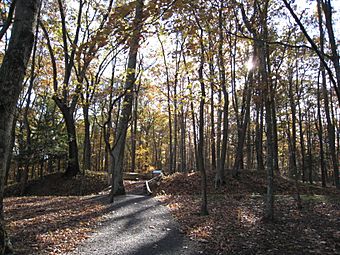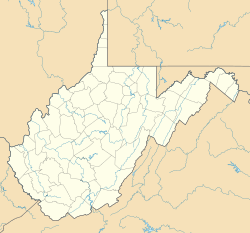Fort Mill Ridge Civil War Trenches facts for kids
Quick facts for kids |
|
|
Fort Mill Ridge Civil War Trenches
|
|
 |
|
| Location | Fort Mill Ridge Rd., Romney, West Virginia |
|---|---|
| Area | 201 acres (81 ha) |
| Built | c. 1861-1862 |
| NRHP reference No. | 13001121 |
| Added to NRHP | January 22, 2014 |
The Fort Mill Ridge Civil War Trenches are special ditches dug a long time ago in West Virginia. They were made between 1861 and 1862 during the American Civil War. These trenches were used to help protect the town of Romney.
Soldiers from the Confederate side first dug these trenches. They lined them with strong chestnut logs. Their goal was to protect important roads and rivers leading to Romney. Later, between March and June 1863, Union soldiers fixed up these trenches. Even though Confederates built them, Union forces controlled them for most of the war.
Contents
Discovering the Fort Mill Ridge Trenches
The Fort Mill Ridge trenches are thought to be the best-kept Civil War trenches still around today. They are located about three miles southwest of Romney. You can find them near the Fort Mill Ridge Wildlife Management Area. This area is close to a main road called the Northwestern Turnpike (U.S. Route 50/West Virginia Route 28).
Visiting the Civil War Museum
If you want to learn more, there is a Civil War museum nearby. It tells the story of how the Fort Mill Ridge trenches were built and used. This museum is inside the Taggart Hall Civil War Museum & Visitors Center. You can find it in downtown Romney.
Why These Trenches Are Important
These trenches are important for two main reasons. First, they were part of real battles during the Civil War. Second, they show amazing military engineering. The way the Confederates built them is a great example of a "rammed earth fortification." This means they used packed earth to build strong defenses.
This type of building helped protect important transportation routes. It also brought a new way of fighting to warfare. Instead of fighting only in open fields, soldiers could now use trenches for protection. This defensive method kept soldiers safer and helped protect supplies moving through the area.
The Fort Mill Ridge Civil War Trenches were added to the National Register of Historic Places in 2014. This means they are recognized as a very important historical site.
See also




